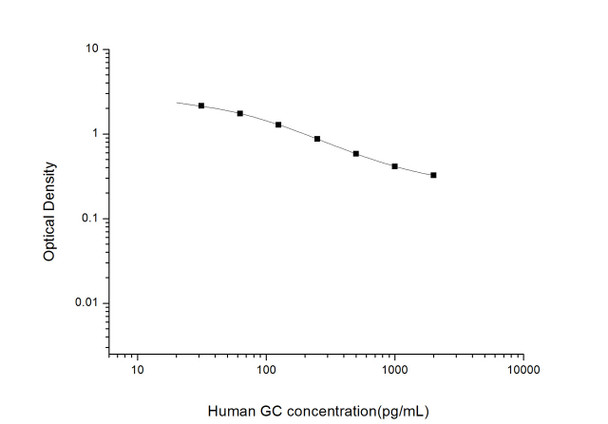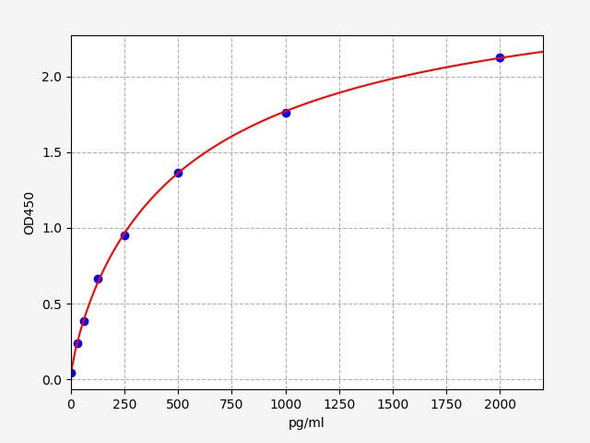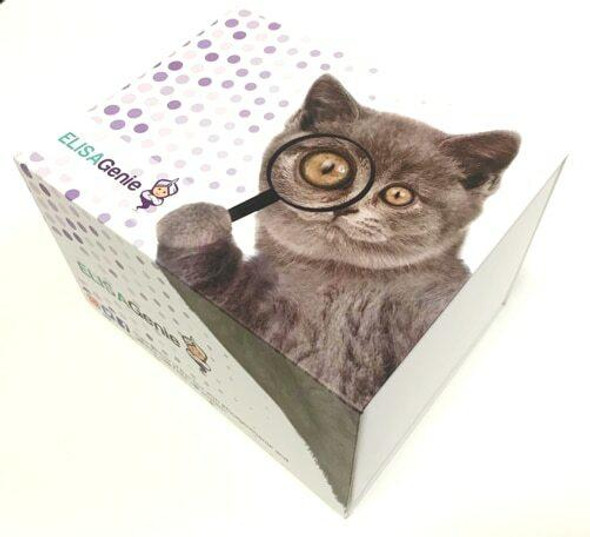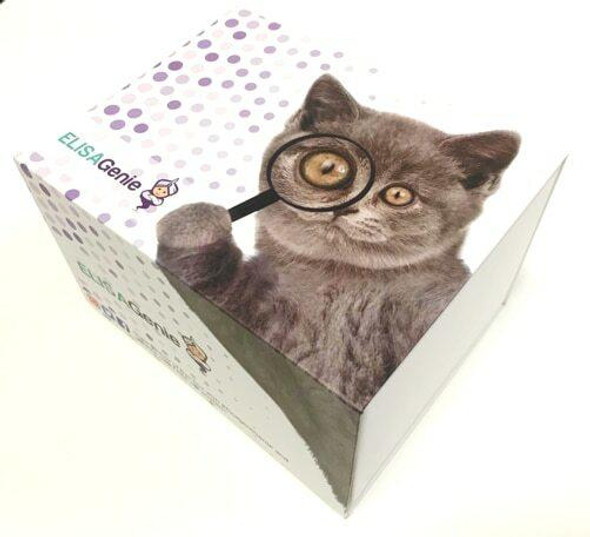Human Cell Biology ELISA Kits 1
Human GC (Glucagon) ELISA Kit (HUES03123)
- SKU:
- HUES03123
- Product Type:
- ELISA Kit
- Size:
- 96 Assays
- Uniprot:
- P01275
- Sensitivity:
- 18.75pg/mL
- Range:
- 31.25-2000pg/mL
- ELISA Type:
- Competitive
- Synonyms:
- GCG, GRPP
- Reactivity:
- Human
- Sample Type:
- Serum, plasma and other biological fluids
- Research Area:
- Cell Biology
Description
| Assay type: | Competitive-ELISA |
| Format: | 96T |
| Assay time: | 2.5h |
| Reactivity: | Human |
| Detection Method: | Colormetric |
| Detection Range: | 31.25-2000 pg/mL |
| Sensitivity: | 18.75 pg/mL |
| Sample Volume: | 50µL |
| Sample Type: | Serum, plasma and other biological fluids |
| Specificity: | This kit recognizes Human GC in samples. No significant cross-reactivity or interference between Human GC and analogues was observed. |
This ELISA kit uses Competitive-ELISA as the method. The microtiter plate provided in this kit has been pre-coated with Human GC. During the reaction, Human GC in the sample or standard competes with a fixed amount of Human GC on the solid phase supporter for sites on the Biotinylated Detection Ab specific to Human GC. Excess conjugate and unbound sample or standard are washed from the plate, and Avidin conjugated to Horseradish Peroxidase (HRP) are added to each microplate well and incubated. Then a TMB substrate solution is added to each well. The enzyme-substrate reaction is terminated by adding Stop Solution and the color change is measured spectrophotometrically at a wavelength of 450 nm ± 2 nm. The concentration of Human GC in the samples is then determined by comparing the OD of the samples to the standard curve.
| UniProt Protein Function: | GCG: Glucagon plays a key role in glucose metabolism and homeostasis. Regulates blood glucose by increasing gluconeogenesis and decreasing glycolysis. A counterregulatory hormone of insulin, raises plasma glucose levels in response to insulin-induced hypoglycemia. Plays an important role in initiating and maintaining hyperglycemic conditions in diabetes. Glucagon release is stimulated by hypoglycemia and inhibited by hyperglycemia, insulin, and somatostatin. GLP-1 and GLP-2 are induced in response to nutrient ingestion. Glucagon is secreted in the A cells of the islets of Langerhans. GLP-1, GLP-2, oxyntomodulin and glicentin are secreted from enteroendocrine cells throughout the gastrointestinal tract. GLP1 and GLP2 are also secreted in selected neurons in the brain. Belongs to the glucagon family. |
| UniProt Protein Details: | Protein type:Secreted, signal peptide; Secreted; Hormone Chromosomal Location of Human Ortholog: 2q36-q37 Cellular Component: extracellular space; endoplasmic reticulum lumen; extracellular region; plasma membrane Molecular Function:identical protein binding; protein binding; hormone activity; glucagon receptor binding; receptor binding Biological Process: positive regulation of protein binding; positive regulation of histone H3-K4 methylation; signal transduction; positive regulation of peptidyl-serine phosphorylation; G-protein signaling, coupled to cAMP nucleotide second messenger; response to starvation; G-protein coupled receptor protein signaling pathway; cell proliferation; cellular protein metabolic process; positive regulation of protein kinase activity; positive regulation of cAMP biosynthetic process; energy reserve metabolic process; feeding behavior; regulation of insulin secretion; negative regulation of apoptosis |
| NCBI Summary: | The protein encoded by this gene is actually a preproprotein that is cleaved into four distinct mature peptides. One of these, glucagon, is a pancreatic hormone that counteracts the glucose-lowering action of insulin by stimulating glycogenolysis and gluconeogenesis. Glucagon is a ligand for a specific G-protein linked receptor whose signalling pathway controls cell proliferation. Two of the other peptides are secreted from gut endocrine cells and promote nutrient absorption through distinct mechanisms. Finally, the fourth peptide is similar to glicentin, an active enteroglucagon. [provided by RefSeq, Jul 2008] |
| UniProt Code: | P01275 |
| NCBI GenInfo Identifier: | 125987831 |
| NCBI Gene ID: | 2641 |
| NCBI Accession: | P01275. 3 |
| UniProt Secondary Accession: | P01275,Q53TP6, A6NN65, |
| UniProt Related Accession: | P01275 |
| Molecular Weight: | 20,909 Da |
| NCBI Full Name: | Glucagon |
| NCBI Synonym Full Names: | glucagon |
| NCBI Official Symbol: | GCG |
| NCBI Official Synonym Symbols: | GLP1; GLP2; GRPP |
| NCBI Protein Information: | glucagon; preproglucagon; glucagon-like peptide 1; glucagon-like peptide 2; glicentin-related polypeptide |
| UniProt Protein Name: | Glucagon |
| UniProt Synonym Protein Names: | Incretin hormone |
| Protein Family: | Glucagon |
| UniProt Gene Name: | GCG |
| UniProt Entry Name: | GLUC_HUMAN |
As the OD values of the standard curve may vary according to the conditions of the actual assay performance (e. g. operator, pipetting technique, washing technique or temperature effects), the operator should establish a standard curve for each test. Typical standard curve and data is provided below for reference only.
| Concentration(pg/mL) | O.D | Average |
| 2000 | 0.309 0.339 | 0.324 |
| 1000 | 0.392 0.436 | 0.414 |
| 500 | 0.594 0.572 | 0.583 |
| 250 | 0.858 0.884 | 0.871 |
| 125 | 1.297 1.269 | 1.283 |
| 62.5 | 1.748 1.744 | 1.746 |
| 31.25 | 2.139 2.157 | 2.148 |
| 0 | 2.745 2.751 | 2.748 |
Precision
Intra-assay Precision (Precision within an assay): 3 samples with low, mid range and high level Human GC were tested 20 times on one plate, respectively.
Inter-assay Precision (Precision between assays): 3 samples with low, mid range and high level Human GC were tested on 3 different plates, 20 replicates in each plate.
| Intra-assay Precision | Inter-assay Precision | |||||
| Sample | 1 | 2 | 3 | 1 | 2 | 3 |
| n | 20 | 20 | 20 | 20 | 20 | 20 |
| Mean (pg/mL) | 96.10 | 209.10 | 817.70 | 86.80 | 218.30 | 757.10 |
| Standard deviation | 6.30 | 11.50 | 33.50 | 5.20 | 10.70 | 39.40 |
| C V (%) | 6.56 | 5.50 | 4.10 | 5.99 | 4.90 | 5.20 |
Recovery
The recovery of Human GC spiked at three different levels in samples throughout the range of the assay was evaluated in various matrices.
| Sample Type | Range (%) | Average Recovery (%) |
| Serum (n=5) | 87-102 | 93 |
| EDTA plasma (n=5) | 88-99 | 94 |
| Cell culture media (n=5) | 92-106 | 99 |
Linearity
Samples were spiked with high concentrations of Human GC and diluted with Reference Standard & Sample Diluent to produce samples with values within the range of the assay.
| Serum (n=5) | EDTA plasma (n=5) | Cell culture media (n=5) | ||
| 1:2 | Range (%) | 100-115 | 87-100 | 94-107 |
| Average (%) | 105 | 94 | 99 | |
| 1:4 | Range (%) | 90-104 | 87-101 | 97-113 |
| Average (%) | 96 | 94 | 103 | |
| 1:8 | Range (%) | 89-103 | 92-102 | 95-111 |
| Average (%) | 95 | 97 | 101 | |
| 1:16 | Range (%) | 89-103 | 89-105 | 97-112 |
| Average (%) | 95 | 96 | 103 |
An unopened kit can be stored at 4°C for 1 month. If the kit is not used within 1 month, store the items separately according to the following conditions once the kit is received.
| Item | Specifications | Storage |
| Micro ELISA Plate(Dismountable) | 8 wells ×12 strips | -20°C, 6 months |
| Reference Standard | 2 vials | |
| Concentrated Biotinylated Detection Ab (100×) | 1 vial, 120 µL | |
| Concentrated HRP Conjugate (100×) | 1 vial, 120 µL | -20°C(shading light), 6 months |
| Reference Standard & Sample Diluent | 1 vial, 20 mL | 4°C, 6 months |
| Biotinylated Detection Ab Diluent | 1 vial, 14 mL | |
| HRP Conjugate Diluent | 1 vial, 14 mL | |
| Concentrated Wash Buffer (25×) | 1 vial, 30 mL | |
| Substrate Reagent | 1 vial, 10 mL | 4°C(shading light) |
| Stop Solution | 1 vial, 10 mL | 4°C |
| Plate Sealer | 5 pieces | |
| Product Description | 1 copy | |
| Certificate of Analysis | 1 copy |
- Set standard, test sample and control (zero) wells on the pre-coated plate and record their positions. It is recommended to measure each standard and sample in duplicate. Note: add all solutions to the bottom of the plate wells while avoiding contact with the well walls. Ensure solutions do not foam when adding to the wells.
- Add 50µL of Standard, Blank or Sample to their respective wells. The blank well is added with Sample / Standard dilution buffer.
- Immediately add 50 µL of Biotin-detection antibody working solution to each well.
- Cover with a plate seal and gently tap the plate to ensure thorough mixing. Incubate for 45minutes at 37°C.
- Aspirate or decant the solution from the plate and add 350µL of wash buffer to each welland incubate for 1-2 minutes at room temperature. Aspirate the solution from each well andclap the plate on absorbent filter paper to dry. Repeat this process 3 times. Note: a microplatewasher can be used in this step and other wash steps.
- Add 100µL of HRP Conjugate working solution to each well and over with a plate seal. Incubate for 30 minutes at 37°C.
- Repeat the aspiration/wash process 5 times according to step 5.
- Add 90µL of the Substrate reagent to each well and cover with a new plate seal. Incubatefor approximately 15 minutes at 37°C and protect from light. The reaction time can beshortened or extended according to the colour change, but not by more than 30 minutes. Whenapparent gradient appears in standard wells, terminate the reaction.
- Stop: Add 50µL of Stop Solution to each well (wells will develop a yellow color immediately). Note: Adding the stop solution should be done in the same order as the substrate solution.
- Determine the optical density (OD value) of each well immediately with a microplate readerset at 450 nm. In advance, preheat the instrument and set the testing parameters.






